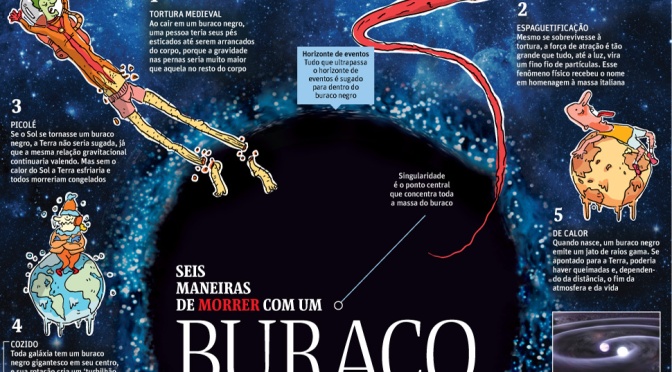Let’s give a warm welcome to Henrique Gubolin, my new graduate student. Let’s hear from Henrique himself:
Hi! I’m Henrique Gubolin Torres, and I’m starting my masters degree under the supervision of Rodrigo Nemmen; I just graduated in physics at IF-USP and I already worked with galaxy clusters and simulations before.
In this new project, I’ll be doing black hole simulations with the help of some well known magnetohydrodynamic codes, of course. We will simulate gas around a non-spinning black hole (Schwarzschild) using a semi-Newtonian approach and Magnetohydrodynamic (MHD). I’m looking forward to this project and to my new graduate student life, so… here we go!
I recently got a paper accepted to MNRAS with my collaborator Sasha Tchekhovskoy at UC Berkeley. Here are a couple of quick points about the paper:
- Basic idea: take observed black hole systems and treat them as engines. Measure what flows in (fuel) and what comes out (exhaust). Dividing the energy of what comes out by the amount of energy that flows in, we get an energy efficiency.
- We measured this efficiency for 27 nearby supermassive black holes which produce jets (radio galaxies). Our analysis is based on recent Chandra observations and current ideas on accretion disks.
- The results imply that black hole engines are producing more energy than flows in: efficiencies > 100%. This is completely opposite to the general idea that everything disappears inside black holes. Black holes are actually quite “green” (energy-efficient).
- Does this violate energy conservation? No. The extra energy that comes out would be extracted from the spin energy of the black hole.
- What constraints do these results put on black holes physics? In order to explain the data, black holes need to: (i) be rapidly rotating, (ii) be surrounded by strong magnetic fields (see footnote below). Such “dynamically-important” magnetic fields act as catalysts of the energy extraction.
The paper got some coverage in the brazilian press here and here.
ps. The technical name for “strong magnetic fields” is “magnetically arrested disk” (abbreviated as MAD). This is a fashionable idea among theorists that are simulating black hole accretion flows. My collaborator (Tchekhovskoy) is one of the theorists doing such fantastic GRMHD simulations.

Neste Domingo foi publicado no jornal Folha de São Paulo uma reportagem sobre o meu trabalho de divulgação científica sobre buracos negros: veja seis maneiras de morrer com um buraco negro.
A reportagem é muito divertida e gostei especialmente das ilustrações: tragédia no espaço.
Para os curiosos que lerem esta postagem e a reportagem da Folha, seguem esclarecimentos sobre alguns ponto do texto:
- As maneiras 1 e 2 de morrer no artigo são uma consequência do mesmo fenômeno físico, chamado de forças de maré e causado pelo comportamento da atração gravitacional a objetos astronômicos. Este tipo de fenômeno causa as marés na Terra.
- Sobre a maneira 3: não se preocupem, o nosso Sol jamais se tornará um buraco negro porque ele é muito “magrinho”.
- O telescópio de raios gama lançado pela NASA em 2008 chama-se Fermi, e não Glast. Glast era o nome da missão antes do lançamento. Eu estou envolvido com esta missão desde 2011.
- Na reportagem: “analisando os diferentes espectros de radiação emitidos pelos buracos negros […]”. Na verdade, os buracos negros não emitem radiação em si, o que brilha é o turbilhão de gás caindo neles ou o gás que é expulso antes de cair.
- A reportagem menciona que os buracos negros “ejetam mais energia do que absorvem — estão na verdade consumindo sua massa”. Nem todos os buracos negros se comportam desta maneira, mas uma pequena fração deles parece ter este comportamento bizarro, conforme eu e um colaborador temos pesquisado. Os artigos científicos relatando esta descoberta estão aqui e aqui.
Divirtam-se com estas tragédias espaciais!
University of São Paulo / Associate Professor
